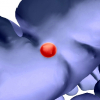Free Online Productivity Tools
i2Speak
i2Symbol
i2OCR
iTex2Img
iWeb2Print
iWeb2Shot
i2Type
iPdf2Split
iPdf2Merge
i2Bopomofo
i2Arabic
i2Style
i2Image
i2PDF
iLatex2Rtf
Sci2ools
346
click to vote
Publication
Virtual Fly-Over: A New Visualization Technique For Virtual Colonoscopy
In this paper, we propose a new visualization technique for virtual
colonoscopy (VC). The proposed method is called Virtual Fly-Over, which splits
the entire colon anatomy into exactly two halves. Then, it assigns a virtual camera
to each half to perform fly-over navigation, which has several advantages
over both traditional fly-through and related methods. First, by controlling the
elevation of the camera, there is no restriction on its field of view (FOV) angle
(e.g., > 90) to maximize visualized surface areas, and hence no perspective
distortion. Second, the camera viewing volume is perpendicular to each colon
half, so potential polyps that are hidden behind haustral folds are easily found.
Finally, because the orientation of the splitting surface is controllable, the navigation
can be repeated at a different split orientation to overcome the problem of
having a polyp that is divided between the two halves of the colon. Quantitative
experimental results on 15 clinical...
Related Content
| Attachments | Size |
|---|---|
| 534.48 KB |
| Added | 08 Nov 2008 |
| Updated | 22 Dec 2008 |
| Type | Conference |
| Year | 2006 |
| Where | MICCAI (Medical Image Computing and Computer Assisted Intervention) |
| Authors | M. Sabry Hassouna, Aly A. Farag, Robert Falk |
| Attachments | 1 file(s) |
Comments (0)





